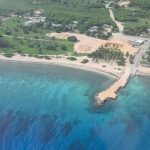One million greens bite the dust

(CNS): Cullers, who have been working for just under twelve months to control what was a serious risk to Cayman’s natural environment from the invasive green iguanas, reached an important milestone Thursday, when the millionth animal was killed. Fred Burton, the head of the Department of Environment Terrestrial Resources Unit, said the landmark was a really important moment but it was essential not to stop the cull just yet.
“This landmark is certainly everything we had hoped for and it is a credit to all the cullers, who took up this huge task with such enthusiasm and determination,” he told CNS at the landmark moment.
But Burton warned of the dangers of a population rebound if the cull was to stop, given the ability of the greens to adapt and breed so profusely.
“Looking ahead, as I have often said, it would be unwise to slack off now. These iguanas are proven to be able to double their population annually, so the one to two hundred thousand that are still out there now could bounce back to where we started in just a few years,” he noted.
Burton explained that the DoE is planning a gradual transition in approach because of the dwindling numbers and the inevitably shrinking of return on the effort of the cullers. He said the DoE, in partnership with the project management contractor, Cornwall Consulting, which has responded to the ever changing demands of the job, would be working out those details in the coming weeks.
He said the aim was to have a new direction in the New Year, assuming funds remain in place, to continue to reduce the numbers to a level where the green iguanas no longer pose a significant risk to the local flora and fauna.
According to the latest population count in August the number of adult greens were estimated to have have fallen by more than 90% as a result of the cull, with as few as 60,000 grown iguanas now hiding in the bush. But the population has been swollen by the hatchlings that emerged during this year’s breeding season, which have not been counted.

Over the past few weeks, the green iguanas taken to the culling station at the George Town landfill have mostly consisted of hatchlings, though there is no direct measure of the numbers. They are, however, the reproductive output of the breeding green iguanas nesting earlier in the year, at a time when there were many more adults than there are now.
The cull has nevertheless proved to be a success. Burton said the budget and business case originally had what was believed at the time to be a very optimistic projection of culling 1.3 million iguanas by the end of 2019. That number was based on the population count in August last year, which estimated there were around that many animals on Grand Cayman at the time.
“We knew there would be a big hatch in 2019 so this wasn’t a ridiculous target, but a very optimistic one nonetheless,” Burton said. “We wanted to be sure we didn’t run out of money in full cull mode, so we budgeted for the best case scenario. ‘Success’ in biological terms, which means being sure to achieve a significant net reduction in the population year on year, occurred when we passed the 800,000 mark. We are now evidently well above that minimum target, and by year’s end the cull is expected to reach around 1.1 million or a little more, but not 1.3 million.”
But getting so close to the target already is an “outstanding result”, Burton said, adding that the beneficial effects can be clearly seen in gardens, farms, roadsides and natural forests all over the island.
“Hopefully over the next couple of years we can reduce the population right down to a level that can be kept suppressed with much less effort and cost,” the iguana expert added.
One of the main challenges and cause for concern has been the disposal of the dead animals, and Burton confirmed that burial is still the only option.
“We had originally hoped incineration would have been an option but the wet biomass is challenging to a traditional small incinerator and by the time the waste-to-energy facility is operational, the cull should have transitioned to a maintenance level only,” he said, noting that hopes for commercial uses of the skin and meat had not materialised.
“Uses of the carcasses continues to be very small scale and makes no significant impact on the volume that has to be disposed of,” Burton added.
- Fascinated
- Happy
- Sad
- Angry
- Bored
- Afraid
Category: Land Habitat, Science & Nature





































Alexa, play another one bite the dust by Queen
Sounds like a job well done for once. I’m old enough to remember the gray squirrel eradication programme in the UK. You got half-a-crown for each tail, which would buy you a box of ten .410 shotgun shells back then. We also got to keep the squirrel meat and that made good stews.
They’re baaaaaack , in my garden at least.
Question: why do Cayman’s leaders trust Fred Burton’s evidence-based input on green iguanas but largely ignore such scientific advice regarding climate change and rising sea levels?
Because they can do something about the iguanas?
Because if you erased these islands from the map, the end result on climate change would be a drop in the ocean almost literally. simple facts
I can’t say enough about this program – I have seen a huge difference! Well done and thanks to all involved.
If we are looking to remove a destructive life form from Grand Cayman, how about humans? Can we please come up with a cost-effective, legal, and morally acceptable way to cull the human population? After all, these bizarre bipeds are far messier and more problematic than green iguanas. Not even close.
Also, just for thought, isn’t it kind of weird and sad that green iguanas can be slaughtered by the tens of thousands like this while we simultaneously love and protect the blue iguanas? I understand the practical need for this action, but still, in the big picture, they are virtually the same life form.
Your ignorance is astounding.
What am I ignorant about? Don’t just name call, bruh, educate me.
He’s “woke”
You first, on the human cull.
Here’s the thing: The green iguanas are INVASIVE. They didn’t originate here; they aren’t indigenous to the Cayman Islands. The SIRI and Blue Iguanas (which are themselves a Rock Iguana) ARE native.
The Green Iguanas — no fault of their own — reproduce at an alarming rate, far outpacing that of the native rock iguanas (both Sister Island Rock Iguanas and the Blues), and consume resources from the habitat of the Rock Iguanas, as well as consuming resources of the humans.
Unlike the Rock Iguanas, the Green Iguanas also consume native bird eggs, and tend to congregate around people. They are (imho) the “rats” of the reptile world. It’s not their fault (the greens), but they were introduced into all three islands artificially, and have spread like a plague.
From what I understand, the Sister Islands volunteer teams have been culling for several years, and are mostly keeping up with the numbers, which are not nearly as profound as that of Grand Cayman.
Agree with you that humans are the most destructive force on the planet. We can do a lot personally to thwart our negative influences.
The Rock Iguanas don’t have any protection from the Greens other than us. This is their land. It is our duty, imo, to protect them. The Blue Iguanas are found only on Grand Cayman.
Um, thanks so much for the schoolboy research paper, Mr. Attenborough, but reread my original comment. I said I understand the practical need for this. My suggestion for further thoughts about it stands. It’s good to think beyond the obvious sometimes. Try it.
#lame
Rock Iguanas are tasty.
To be fair humans are an invasive species in Cayman too.
LMAO…..talk about dumber than a bag full of rocks! I think I’ve heard it all!….
One is still hiding in my tree, sh*tting on my car.
Oops! Sorry about that.
CHICKENS NEXT! They are far more destructive and carry lice,worms and diseases!
They are real pests.
They destroy car paint with their claws
They defecate on cars, roofs and trees
They create constant noise pollution through the night and day
The utterly destroy and dig up gardens, laws and plants
They tear into trash containers ripping bags open, promoting rats to get in there
They constantly cause cars to weave on the road because bleeding-hearts won’t just run them over creating hazard to pedestrian, cyclists and other cars.
They attract tree hugging morons to feed them throughout different neighborhoods creating breeding grounds for chicken infestations also bringing in rats and other pests.
For example there is some bag-lady looking idiot that routinely dumps a container of trash food near the parking lot at and Poinsettia on 7MB to feed the feral chicken and cats, and then runs off the premises. People like that should be arrested, and I hope you are reading this comment you disgusting pig!
lol
Deal with the feral cats first.
Buck buck buckaaaack?!
Start eating them.
“They attract tree hugging morons”
Yea, sure buddy, I’m sure the environment is your priority.
@8:57 they should dump them in your back yard then you can count them and give us the accurate numbers – weekly too please!
Good job. Are the chickens next ?
Amazing!! Now can someone take care of the damn chickens. Those damn roosters won’t shut up!!
cull has improved things…well done.
now can we also admit that the numbers behind this scheme are nonsense?
who counted a million iguanas?
how were they counted?
how are they being disposed of?
Think it’s time to get rid of this broken record. EVERY SINGLE TIME an article comes up on topic of the iguana cull there is ALWAYS someone whinging and questioning the accuracy of the count and asking where the iguanas are disposed of. Its no mystery. You can go down and see the tip and the counting process in action. And all the counts are accurate. the counting job is done by 2 counters at a time and is crossed checked against what the culler states they have brought in. The are literally there with clickers. Give it a rest already and just accept that this cull is having a positive impact on our island.
And just like a broken record they should be tossed out, no use what so ever.
caymanian with a clicker….wow..that explains it!…..zzzzzzzzz
10:03 you don’t have confidence in the counting ability of your fellow Caymanians? Im sorry if you are incompetent in the act of counting but I certainly have no trouble with numbers. Maybe you should get some extra tuition? As for the time frame you do realize this has been running for a year right?
You would be welcome to go to the dump and see for yourself. This conspiracy theory is so weird because it is so easily debunkable. Just go, have a look.
its no conspiracy…the numbers stated are impossible to count with accuracy in that timeframe.
Just go!! Just go to the dump and look. Honestly, I’ll meet you there with a $50 if it would get you to stfu.
I’m gonna pay you $50 to buzz off XD.
@8:57 Dude do yo go to bed at night with these questions on your mind? I think we’re a bit tired of you asking the same dumb questions. Common sense should tell you that the fact iguanas are now rarely seen, the numbers make sense.
One guy counting one iguana every 5 seconds = 12 per minute = 720 per hour = 5040 every 7 hours = 1,008,000 in 200 days. I’m pretty sure I can do better than twelve a minute, I think I could do 60 a minute and take the next 5 minutes off, and think what you could do with two guys. Then you shove them in a hole and cover them up. Please find something else to be suspicious about, there are plenty of choices.
re-read your post….and then think about it.
yep, still good. just give up dude.
Fred it is time you obtain approval from those land owners that are allowing these pests to breed. If they continue to play hard ball then fine them for every iguana you count on their property.
Ever heard of “Private Property”?
Who is certifying these #’s and better than that, is there an audit program in place or is the the “Caymanian honor system?” Smells like a program that is designed to be as unaccountable as possible!
Smells more like you haven’t taken the time to find out how the counting is checked and double-checked, but prefer to try and sound smug and intelligent by being vacuously cynical. Newsflash: it ain’t working. Nice ratio, btw.
I still think some sort of iguana jerky should be developed and sold to the tourists as a souvenir.
Well done cullers! The work you are doing is important; please don’t let up until the green iguanas’ numbers are as close to nil as we can get.
…… and a special shout out to the Sister Islands’ volunteer teams. You are making a difference.
I think you will have up the bounty in order to make it worthwhile to the cullers because it will become much harder to find them but the overall $ amount should still be less.
You must also drive a taxi…